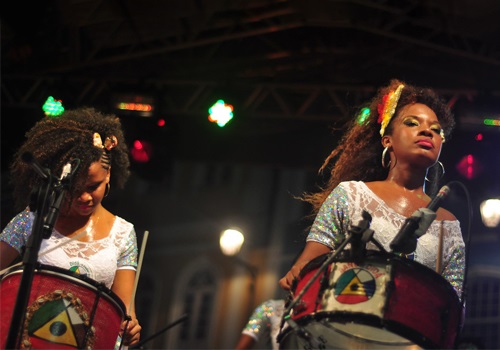June 30, 2021 by Cynthia Macdonald – A&S News
Brazil is a country known for its racial, cultural, sexual and religious diversity. It is also one where staggering economic inequality — its six richest men own the same wealth as 50 per cent of the population — is often matched by a climate of violence and intolerance toward those who are not white, male and heterosexual.
Andrea Allen has spent her professional life researching marginalized people in Brazil, particularly Black women in the LGBTQ community. Allen is an assistant professor with the Department of Anthropology and the Centre for Diaspora & Transnational Studies in the Faculty of Arts & Science. Her 2015 book Violence and Desire in Brazilian Lesbian Relationships showed that while lesbian women in the country reject the cultural norm of male domination and female submission, they themselves are not exempt from intimate partner violence in their own relationships.
Allen found her way to Brazil through a fortunate accident. “In many ways I owe my interest in Brazil to the United States military,” she says. While still an undergraduate, she joined the United States Army Reserve and was given the opportunity to learn a second language — which just happened to be Portuguese. “I mean, I had no choice in the matter,” Allen recalls. “I was an enlisted soldier.”
Returning to university as a double major in religion and African American studies, Allen’s newfound linguistic fluency merged with her interest in the Brazilian religion of Candomblé. Like Santeria and Vodun (also known as voodoo), Candomblé is a new world religion originally practiced by enslaved people from Africa. “For my senior year, I did an independent research project about the experiences of LGBT practitioners of Candomblé,” she says. “There was a perception that this religion celebrated same-sex sexuality, so I was particularly interested in learning about the experiences of lesbian women with it.”
Years later, Allen’s PhD dissertation would also emanate from research conducted in Brazil — but on a very different topic. Initially, “I wanted to focus on the relationship between nationalist ideologies and nationalism, and how they might influence lesbian women,” she says.
However, the link proved hard to make. And while talking to her subjects, she started to notice something else.
“They’d say, my girlfriend slapped me. Or, here’s a bruise, here’s a scar that I got from my girlfriend. The more I talked to people, the more I realized that this was a common experience. And once I began to realize that intimate partner violence was an important theme of my research, another closely related theme was infidelity.”
One of the things I argue is that when we talk about violence, it’s important to look at it not only as a product of masculinity, but as a human enterprise. We can then look at how the histories of different peoples and places can influence and shape how people think about violence.
Intimate partner violence is indeed common in Brazil, where 25 per cent of women are estimated to be physically victimized by men. As Allen found, however, this phenomenon was also very much present in lesbian relationships.
“One of the things I argue is that when we talk about violence, it’s important to look at it not only as a product of masculinity, but as a human enterprise. We can then look at how the histories of different peoples and places can influence and shape how people think about violence,” she says.

Allen’s research has largely been conducted in the port city of Salvador de Bahia, where the population is 80 per cent Black. And yet, the city’s municipal leadership is overwhelmingly white, and on average whites earn over three times what Blacks do.
Consequently, Allen argues that to be not only Black, but female and queer in Salvador, is to be “invisible” with few outlets for expression. This frustration has given rise to a vibrant culture of protest in the city — beautiful and joyful to tourists, but rooted in sorrow. Street paintings are one example of this; another is Banda Didá, an extraordinary all-female drumming group.
“Culture in itself is a form of activism,” Allen says. “The fact that Banda Didá is an all-female drum corps is significant, because in many Candomblé temples, only men are allowed to play drums during religious ceremonies.”
Religion is of course part of culture, and it is to religion that Allen will return for her next book. When she was completing a master of theological studies degree at Harvard Divinity School, she noted how Brazilian immigrant women in the Boston area would use religion to relieve the many stresses caused by dislocation. This led to her interest in how the LGBTQ community in both Brazil and the diaspora interacts with evangelical Protestantism.
In Brazil the question is fraught, given the increasing involvement of right-wing evangelicals in Brazilian politics.
But only lately, says Allen, has evangelical religion become politicized. “If you look at the history of mainstream evangelicalism, you see this idea that ‘we should not be of this world.’ But the last time I was in Brazil, at a church run by two lesbian pastors, one of the pastors’ sermons criticized evangelicalism for not following the true spirit of the Word.”
Allen’s continuing research shows that while Brazil’s cultural richness is justifiably the envy of the world, it is also a country beset by myths. Chief among these is its reputation as a model of racial and sexual tolerance.
“White Brazilians like to think of Brazil as a land of happiness, almost a racial paradise. But if you look underneath, you see a lot of racial, sexual and gender inequality. You can’t look at any one of these things without looking at the others,” she says. “Because that is the history of Brazil.”


